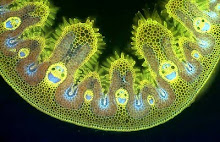You don't need to be a gardener for very long before you discover that within every species there are always a few plants that don't conform to the norm. They're either mutants (where changes in their genes produce a different shape, form or colour of plant) or they're monstrosities (where there some external agency, like environmental stress or disease has led to abnormal growth).
Only mutants produce heritable changes, that will be passed on to at least some of their progeny. I would guess that the abnormal ox-eye daisy (Leucanthemum vulgare) above is a mutant. Some of its florets are spoon-shaped and since this abnormal plant turned up in my garden a few years ago others have appeared in subseqient years with the same characteristic, probably arising from seeds produced from those abnormal florets. Cultivars of a number of daisy-like species that have flowers composed entirely of spoon-shaped petals have been bred, so it's highly likely that this is a genetically controlled change in the pattern of petal development.
I'm pretty certain, on the other hand, that this two-headed ox-eye daisy is a monstrosity, the result of some agency that has interfered with the normal development of the flower and produced twin heads. Temperate-shock (i.e. frost) can sometimes do this.
This monstrous spear thistle Cirsium vulgare is the result of several flower heads becoming joined, side by side into a cock'scomb-like inflorescence, probably as a result of either stress during a critical phase of flower bud development or perhaps infection with a bacterium - Corynebacterium is known to cause a similar phenomenon, known as fasciation, in ...
Linaria purpurea...
Forsythia x intermedia, where it causes a switch in symmetry of the stem, from radial symmetry to flat, plank-like growth...
... and occasionally in herbaceous species like candelabra primulas ......
Some mutant forms of growth are widely cultivated for human consumption, like the cauliflower - which is a mutant inflorescence where the flower buds proliferate to the extent that they can no longer open properly.
My favourite monstrosity, though, is to be found in foxgloves Digitalis purpurea, where occasionally the last flower to form at the top of the floral axis results from fasciated growth of several flower buds. If you compare the monstrous flower on the left with the normal one on the right you can see that it has four stigmas, styles and ovaries, within a single tubular corolla - four flower buds fused to form a single flower.





















